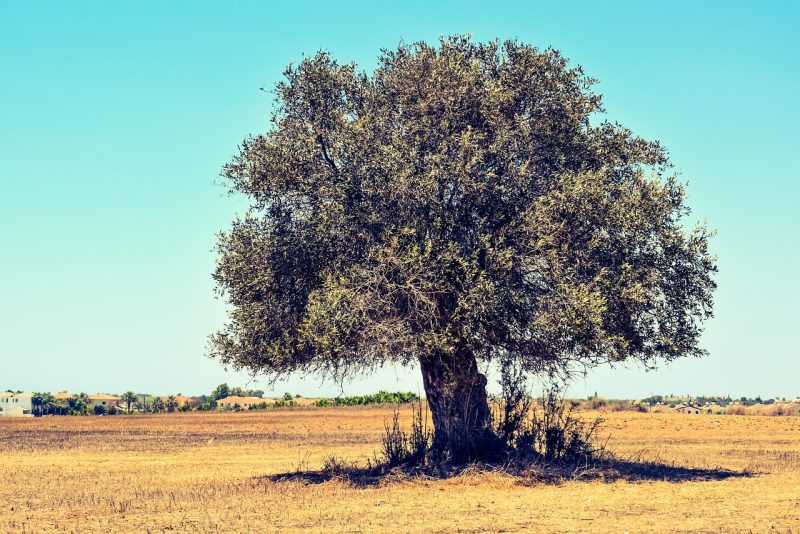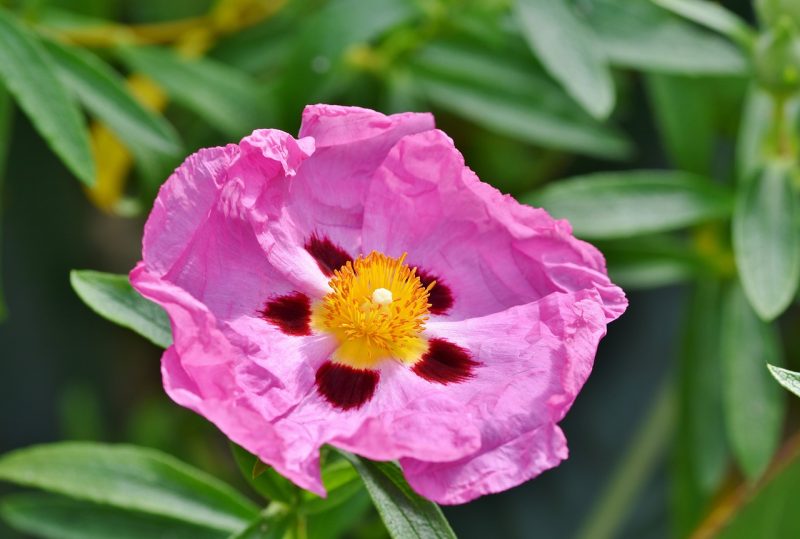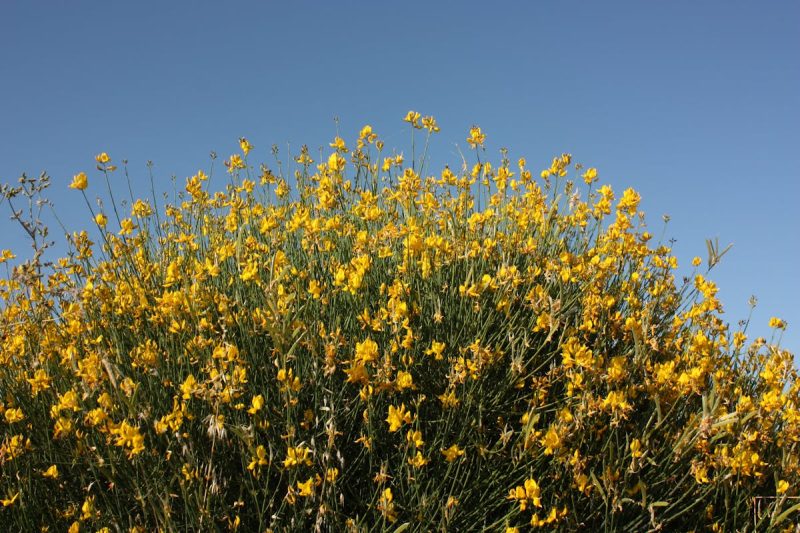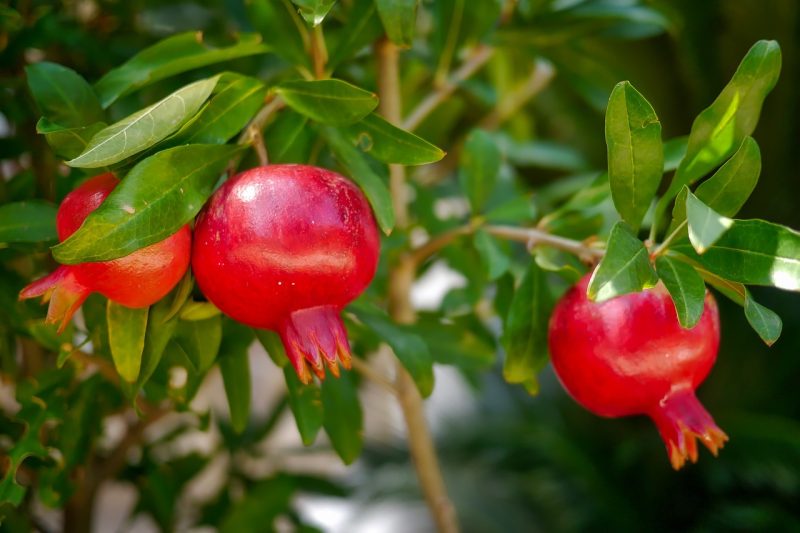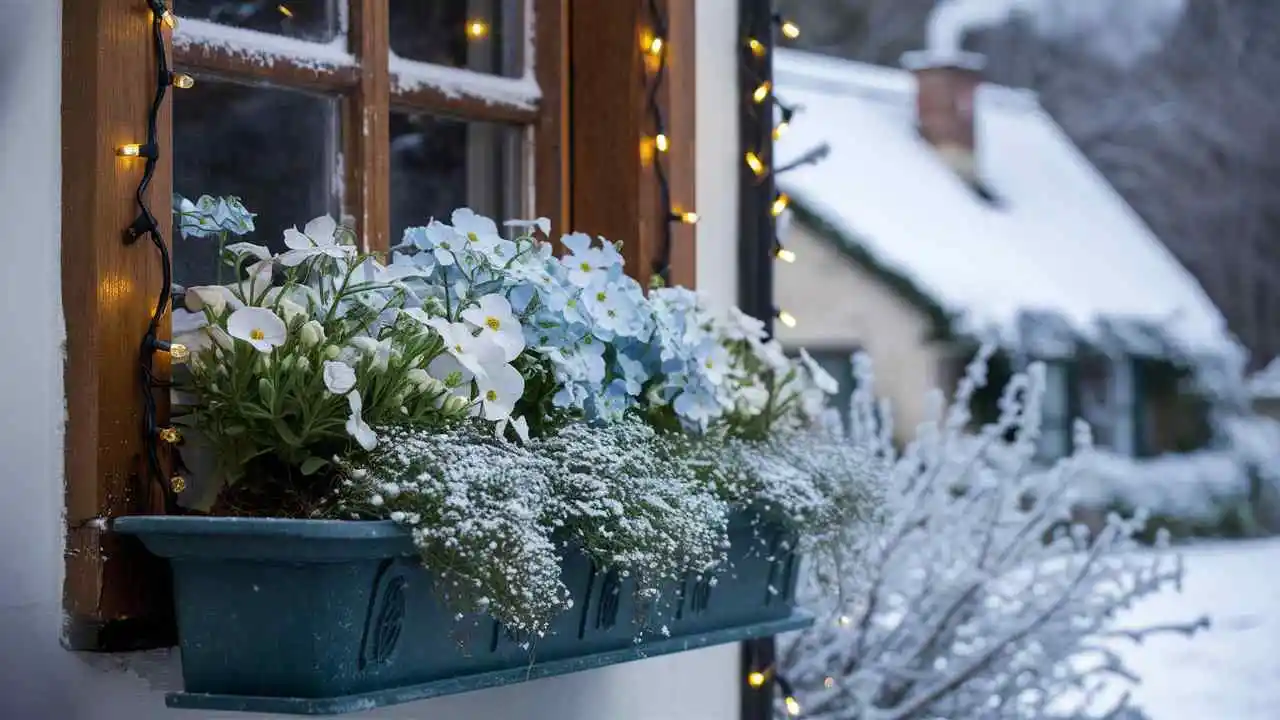The Mediterranean climate, characterized by hot, dry summers and mild, wet winters, nurtures a diverse array of flora uniquely adapted to thrive in such conditions. On this page, you’ll find plants that not only beautify Mediterranean gardens but also reflect the resilience and charm of this enchanting region.
Lavender (Lavandula angustifolia)
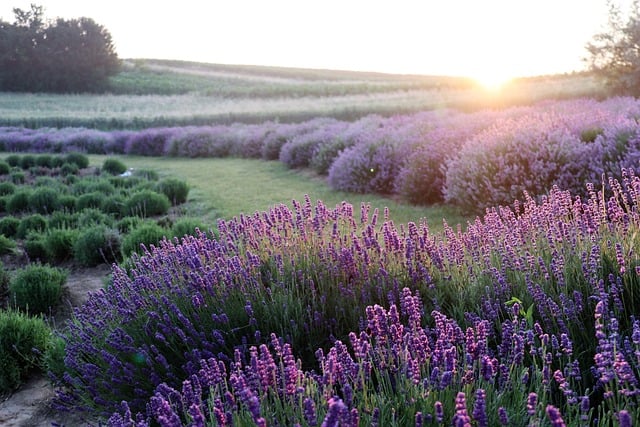
Lavender is an iconic plant that embodies the essence of Mediterranean gardens, celebrated for its stunning purple flowers and captivating fragrance. This perennial herb is not only a visual delight but also an essential component in aromatherapy and culinary applications. With its ability to tolerate drought, it requires minimal water once established, making it a perfect choice for eco-friendly gardening.
The flowers of Lavandula angustifolia bloom in midsummer, attracting pollinators such as bees and butterflies, which adds a lively dimension to the garden. Beyond its ornamental value, lavender is prized for its oil, which has therapeutic properties including stress relief and antiseptic qualities. When planted in well-drained, sandy soil, lavender thrives under full sun exposure, making it an essential addition to the Mediterranean garden.
Moreover, lavender’s versatility extends beyond the garden; it can be harvested and used in sachets, potpourri, and even culinary dishes, where it adds a unique flavor profile. Cultivators often enjoy various cultivars of lavender, each presenting a distinct hue, height, and scent, allowing for a customized and vibrant landscape.
Rosemary (Rosmarinus officinalis)
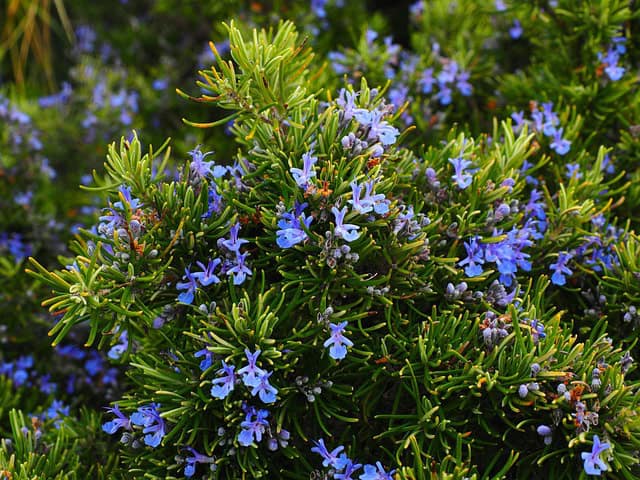
Another quintessential Mediterranean garden plant, rosemary is a semi-aromatic evergreen shrub that is cherished for its ability to enhance both dishes and landscapes. Rosemary’s needle-like leaves exude a strong, invigorating aroma that enhances culinary creations, making it a staple in Mediterranean cuisine where it pairs beautifully with meats, potatoes, and breads.
This hardy herb can reach up to 4 feet in height, often forming dense, sprawling bushes that provide shelter and food for various birds and insects. Known for its drought-resistant capabilities, rosemary thrives in poor, well-drained soil and prefers full sunlight, making it a low-maintenance option for gardeners in Mediterranean climates. Beyond its culinary uses, rosemary is also believed to enhance memory and stimulate cognitive function, adding a layer of interest to its cultivation.
For those looking to incorporate rosemary into their gardens, consider growing it alongside other herbs or flowering plants for a stunning display of color and texture. Whether clipped into a topiary shape or left to grow naturally, rosemary serves as a functional and decorative element that enhances the charm of the Mediterranean garden.
Oleander (Nerium oleander)

Oleander is a striking choice for Mediterranean gardens, renowned for its stunning clusters of trumpet-shaped flowers that come in vibrant shades of pink, red, yellow, and white. This evergreen shrub is both resilient and drought-tolerant, making it an ideal plant in regions with prolonged dry spells. With its ability to grow up to 20 feet tall, oleander can create stunning hedges or serve as a standout specimen plant.
However, while oleander’s beauty is undeniable, it is crucial to be aware of its toxicity. All parts of the plant contain compounds that can be harmful if ingested, making it a less suitable choice for gardens frequented by pets or small children. Nevertheless, in areas where these concerns are managed, oleander’s hardiness and striking appearance make it a popular choice for landscape design.
Oleander flourishes in well-drained soil and offers a majestic aesthetic when planted in groups. The plant’s continuous blooming period throughout the summer ensures that gardens remain alive with color when many other plants begin to wilt under the summer heat. Additionally, oleander’s sheer walls of flowers provide a much-needed protection from wind, enabling a microclimate beneficial for other Mediterranean plants.
Bougainvillea (Bougainvillea spp.)

Bougainvillea is a dazzling display of color, with its vibrant bracts that glow in shades of magenta, purple, red, orange, and white. This fast-growing, climbing vine is ideal for adding vertical interest and creating lush, tropical vibes in a Mediterranean garden. Native to South America, bougainvillea thrives in sunny, warm climates, making it perfectly suited for Mediterranean conditions.
One of the remarkable traits of bougainvillea is its ability to adapt to various soil types, although it prefers well-draining soils rich in organic material. This plant shows resilience against drought; once established, it requires minimal water, making it a water-wise choice for gardeners looking to conserve resources.
In addition to its ornamental use, bougainvillea can create natural privacy screens and beautiful focal points when draped over arbors or trellises. For a particularly stunning effect, consider contrasting the bright bougainvillea colors with lush green foliage or olive trees. They also attract butterflies and hummingbirds, bringing a dynamic wildlife element to the garden. Careful pruning can encourage more blooms and control the plant’s growth, ensuring it remains a vibrant highlight without overtaking other garden favorites.
Olive Tree (Olea europaea)
The olive tree is emblematic of Mediterranean culture, deeply intertwined with the history, cuisine, and economy of the region. Renowned for its iconic gnarled trunks and silvery green leaves, the olive tree brings architectural interest and timeless beauty to the Mediterranean garden. These hardy trees are well-suited to the Mediterranean climate, thriving in well-drained, rocky soil and requiring full sun for optimal growth.
Olive trees are highly drought-resistant, once established, making them an excellent choice for xeriscaping or water-wise gardens. Beyond their aesthetic appeal, olive trees bear fruit: the small, nutrient-dense olives are harvested for oil, a staple in Mediterranean cuisine known for its flavor and health benefits. This dual functionality—offering both beauty and sustenance—makes the olive tree a significant addition to any Mediterranean garden.
In terms of care, olive trees are relatively low-maintenance, requiring occasional pruning to maintain their shape and allow for air circulation among the branches. They can be grown in containers, making them an ideal option for patios or courtyards, further extending their versatility. Given their longevity, with some trees living for centuries, they symbolize endurance and resilience and can be cherished as heirlooms in the garden landscape.
Italian Cypress (Cupressus sempervirens)
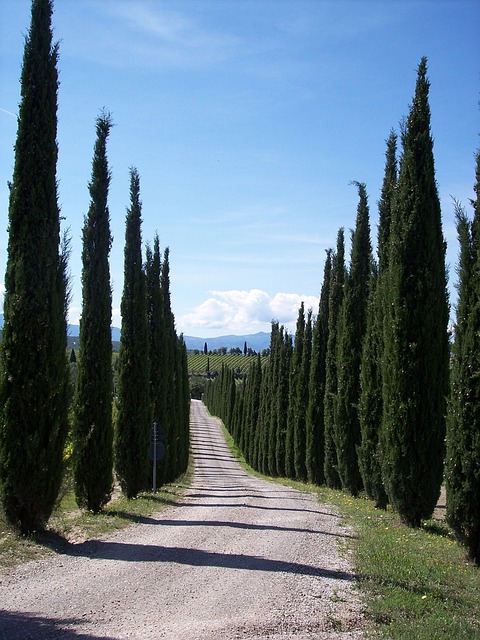
The Italian cypress stands tall and regal in Mediterranean gardens, known for its slender, columnar shape that punctuates the landscape with vertical lines. This evergreen conifer, native to the eastern Mediterranean, is synonymous with landscapes in Italy and is often seen lining driveways or marking the boundaries of vineyards and estates.
Its hardy nature and ability to thrive in dry, rocky soils make it especially suited for the Mediterranean climate. Italian cypress requires minimal watering once established, making it an ideal component in low-maintenance gardens. With its rich dark green foliage, the cypress provides a beautiful contrast to the vivid blooms of other Mediterranean plants.
Beyond its ornamental appeal, the Italian cypress carries significant cultural symbolism, often representing strength and immortality in Mediterranean traditions. For gardeners, this tree can act as a natural privacy screen or windbreak due to its height and dense growth habit. When grouped in clusters, they create dramatic focal points that enhance the architectural dimensions of the garden.
It’s important to note that while the Italian cypress is generally resistant to pests, it should be planted with enough space between other plants to allow proper air circulation. This helps prevent any potential issues related to fungal diseases. When carefully placed, the Italian cypress can transform the Mediterranean garden into a sophisticated and timeless landscape.
Geranium (Pelargonium spp.)
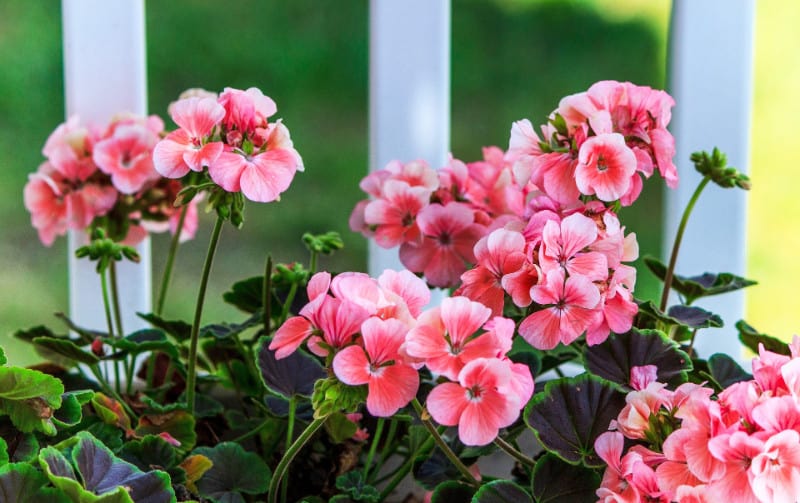
Often synonymous with vibrant garden beds and cheerful window boxes, geraniums bring a splash of color and life to Mediterranean gardens. While commonly referred to as geraniums, many of the plants in this category are technically part of the Pelargonium genus. With a vast array of species and hybrids, these plants can feature flowers in a kaleidoscope of colors, including pink, red, and white, often adorned with striking patterns.
Geraniums are not only visually appealing but also thrive in the Mediterranean climate, flourishing in sunny spots with well-drained soil. Their drought tolerance makes them a perfect addition to water-wise gardens, and once established, geraniums require minimal watering. Due to their versatility, they can be utilized in container gardens, hanging baskets, or as ground cover to create a lush, vibrant tapestry throughout the garden.
In addition to their ornamental value, geraniums possess medicinal properties; they are known for their essential oils, which have antibacterial and antifungal qualities. Some species are even used in traditional herbal remedies. Pruning spent flowers encourages continuous blooming, maintaining a cheerful appearance throughout the growing season. Whether cascading from containers or forming colorful clusters in borders, geraniums inject energy and vitality into any Mediterranean garden.
Sage (Salvia officinalis)
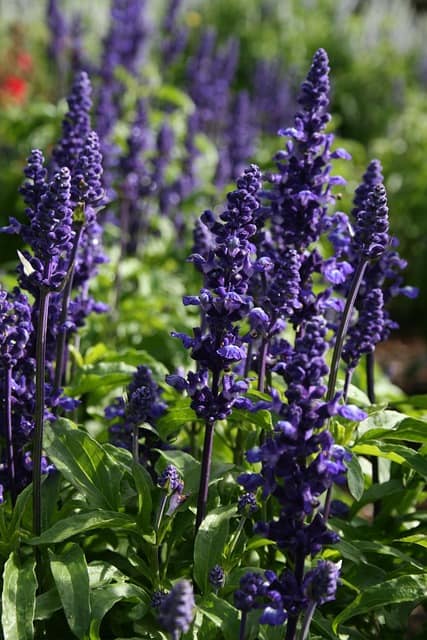
Sage is a staple of Mediterranean gardens, highly valued for its fragrant leaves and culinary versatility. This perennial herb, known scientifically as Salvia officinalis, is a key ingredient in Mediterranean cuisine, complementing dishes such as roast meats, pasta, and vegetable medleys with its earthy flavor.
Beyond its culinary uses, sage is an attractive plant, distinguished by its soft, gray-green leaves and delicate blue-violet flowers that bloom in summer. Its ability to thrive in poor, dry soils makes it a low-maintenance choice, suitable for gardens that emphasize sustainability and drought-tolerance. Sage prefers full sun and, once established, has little need for additional watering, making it an excellent companion for other Mediterranean herbs and plants.
Sage’s aromatic foliage also attracts various pollinators, including bees and butterflies, enhancing the biodiversity of the garden. When planning a Mediterranean garden, consider grouping sage with other herbs, such as thyme and rosemary, not only for a beautiful arrangement but also to create a fragrant sensory experience. Regular pruning helps maintain the plant’s shape and encourages new growth, granting gardeners a continuous supply of fresh leaves for culinary use.
Agapanthus (Agapanthus spp.)
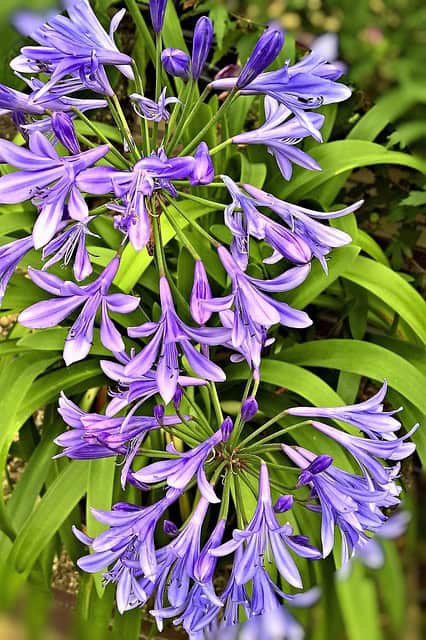
Agapanthus, commonly known as African lilies or blue lilies, adds a striking architectural element to the Mediterranean garden, with its tall, slender stems topped by spherical clusters of vibrant blue or white flowers. Native to South Africa, agapanthus is well adapted to warm climates and thrives in well-drained soil, making it perfectly suited for Mediterranean gardens.
The plant typically blooms from mid-summer to early autumn, infusing the garden with colorful splendor just as many other flowering species begin to fade. Agapanthus prefers full sun and is highly tolerant of drought once established, requiring little upkeep, which adds to its popularity among gardeners looking for low-maintenance blooms.
In addition to their aesthetic contributions, these plants can serve several functional purposes within the garden. They work well as border plants or focal points mixed with other perennials and can help attract pollinators, enhancing the garden’s ecological value. Agapanthus also offers landscape versatility; they can be grown in pots to beautify patios or along pathways, creating inviting transitions.
For those looking to cultivate agapanthus, be mindful that some species can be invasive in specific regions. Opting for non-invasive varieties can provide the desired ornamental effect without overwhelming the garden space. With their spectacular blooms and adaptability, agapanthus is a stunning addition to the Mediterranean garden palette.
Rockrose (Cistus spp.)
Rockrose, known scientifically as Cistus, is a stunning addition to any Mediterranean garden, prized for its showy, crinkled flowers and robust adaptability. With over 20 species available, rockrose plants bloom in an array of colors, including white, pink, and deep magenta, creating a spectacular visual display from spring to early summer. These evergreen shrubs are well-suited for hot, dry environments and excel in poor, well-drained soils typical of Mediterranean regions.
The unique, aromatic foliage of rockrose contributes an additional sensory experience to the garden; it releases a sweet, resinous fragrance when brushed against, enhancing the experience for anyone who wanders through the garden. Beyond their enticing scents and striking blooms, rockrose plants also play an important role in supporting local ecosystems by attracting pollinators, such as bees and butterflies.
What sets rockrose apart is its remarkable drought resistance. Once established, it thrives with minimal water, making it an excellent choice for sustainable gardening efforts. Additionally, rockrose is often used for erosion control, as its dense growth helps stabilize soil on slopes and hillsides. When planting rockrose, consider grouping various species together to create a colorful and layered landscape that captures the essence of Mediterranean charm.
Lavender Cotton (Santolina chamaecyparissus)
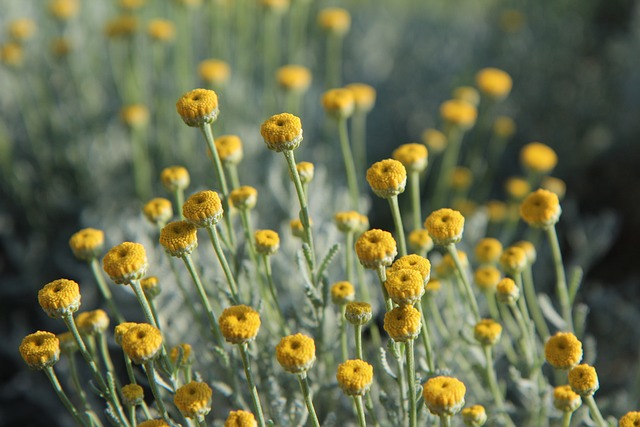
Lavender cotton, or Santolina chamaecyparissus, is a charming, low-growing evergreen shrub that adds both texture and color to Mediterranean gardens. Often used as a ground cover or for edging, this plant features finely textured, silvery-gray foliage that resembles that of lavender, hence its name. Its yellow, button-like flowers bloom in summer, lending a cheerful touch to the garden landscape.
This hardy plant thrives in full sun and well-drained soil, making it particularly suited for the Mediterranean climate, where it tolerates drought once established. Lavender cotton is also known for its resistance to pests and diseases, which are common challenges in many gardens. Its compact form and dense foliage make it an excellent choice for borders or rock gardens, where it can provide contrasting colors and textures among other plants.
In addition to its ornamental value, lavender cotton has historical uses; its leaves were traditionally used for medicinal purposes and the plant itself was employed in the production of essential oils. The aromatic foliage also serves as a natural deterrent to some garden pests, making it a valuable companion plant in vegetable and herb gardens. With its delightful appearance and adaptability, lavender cotton enriches the Mediterranean garden both aesthetically and functionally.
Dwarf Fan Palm (Chamaerops humilis)
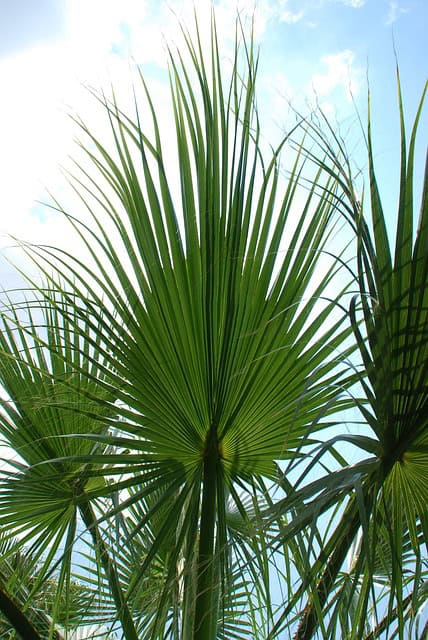
The dwarf fan palm, or Chamaerops humilis, is a striking, hardy palm native to the Mediterranean region. Renowned for its unique fan-shaped leaves, this palm is characterized by its clumping growth habit and can reach heights of around 6 to 10 feet, making it a wonderful option for adding vertical interest to the garden. Its extensive, arching fronds create a lush, tropical feel that contrasts beautifully with the more traditional Mediterranean plants.
One of the dwarf fan palm’s defining features is its remarkable versatility; it can thrive in a variety of soils, from sandy to rocky, and is highly tolerant of drought once established. This adaptability allows it to flourish in Mediterranean gardens with minimal watering, making it a sustainable and low-maintenance choice.
The dwarf fan palm provides more than just an aesthetic presence; it also offers habitat and shelter for various bird species and insects, boosting the biodiversity of the garden. When strategically placed, the palm can create shade and cooling microclimates that benefit more delicate plants nearby. It can also be paired with flowering plants, succulents, or ornamental grasses to create a diverse landscape that celebrates the rich textures and shapes found within the Mediterranean ecosystem.
Moreover, this palm is often prized for its ability to serve as a focal point in garden design, whether planted as a specimen or in small clusters. Its unique structure and resilience make the dwarf fan palm an essential contributor to the Mediterranean garden aesthetic.
Euphorbia (Euphorbia characias)
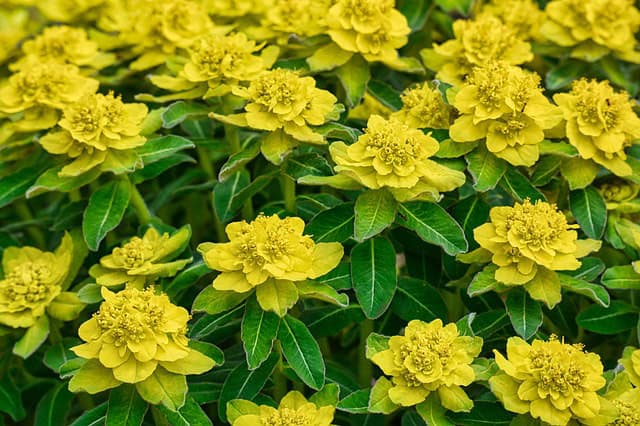
Euphorbia, particularly Euphorbia characias, is a captivating perennial that brings striking aesthetic appeal and versatility to any Mediterranean garden. Known for its unique, architectural form, this plant features greenish-yellow flowers atop tall, sturdy stems, which bloom in spring and summer, creating an eye-catching display. The foliage is typically a rich blue-green, providing a lovely contrast to the vivid flowers and complementing the array of colors found in other Mediterranean plants.
One of the most fascinating aspects of Euphorbia characias is its remarkable adaptability to poor, well-drained soils and its tolerance for drought, making it exceptionally suited for dry climates. It thrives in full sunlight and is known for requiring minimal maintenance once established, allowing gardeners to enjoy its beauty without extensive care.
Euphorbia is also invaluable in ecological terms, as it attracts various pollinators, including bees and butterflies. The plant’s thick, milky sap can deter pests, providing a natural form of defense against unwanted insects. When designing a Mediterranean garden, consider incorporating euphorbia in mixed borders or as a focal point in rock gardens. Its drought tolerance, combined with its visual appeal, ensures it will be a standout feature while supporting the overall ecology of the garden.
Spanish Broom (Spartium junceum)
Spanish broom, or Spartium junceum, is a fragrant, evergreen shrub that brings warmth and vibrancy to Mediterranean landscapes with its vibrant yellow flowers. Blooming from late spring to early summer, these resplendent flowers appear in dense clusters along the slender, broom-like stems, creating a cheerful and inviting atmosphere. The sweet, honeyed scent of the flowers adds an aromatic layer to the garden, enchanting visitors and pollinators alike.
This plant thrives in full sun and offers impressive drought tolerance, making it ideal for regions with limited rainfall. Once established, Spanish broom requires very little irrigation, aligning perfectly with water-sensitive gardening. Its ability to grow in various soil types, including poor and sandy soils, further enhances its appeal in the Mediterranean garden.
Beyond its ornamental qualities, Spanish broom provides erosion control, making it a valuable asset on slopes and unstable terrain. Its deep-rooted system helps maintain soil integrity while its stunning blooms contribute to the visual richness of the landscape. When planting Spanish broom, consider positioning it near paths or entrances, where its fragrant flowers can be appreciated up close.
However, it is essential to note that while beautiful, Spanish broom can become invasive in certain regions, and its spread should be managed carefully. By selecting non-invasive varieties or implementing control measures, gardeners can enjoy the beauty of Spanish broom without compromising the integrity of their landscape.
Agave (Agave americana)
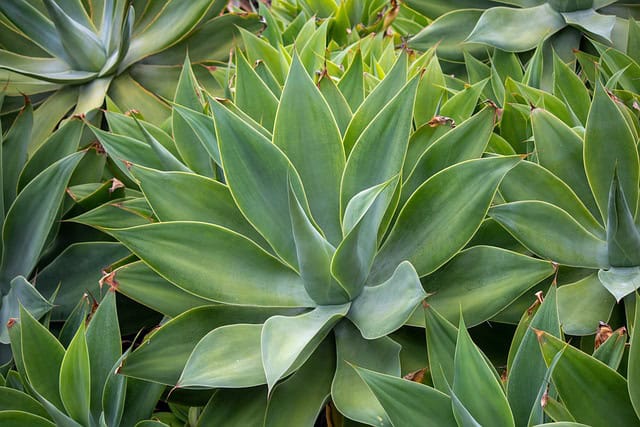
Agave americana, commonly known as century plant or maguey, is a striking, architectural succulent that adds bold drama to the Mediterranean garden. Characterized by its large, fleshy, rosette of thick, spiny leaves, this plant can reach impressive sizes, often measuring several feet in diameter. The dramatic silhouette of agave contrasts beautifully with the softer textures of other plants, making it an ideal focal point or backdrop in garden design.
Native to hot, arid climates, the century plant is exceptionally drought-resistant, thriving in sandy or rocky soils with minimal water requirements. Its ability to store moisture in its leaves allows it to withstand periods of dryness, making it well-suited to Mediterranean conditions. Agave’s tolerance for heat and poor soils makes this plant a favorite among those seeking low-maintenance gardening solutions.
A unique feature of Agave americana is its flowering habit. After several years of growth, often up to 10 to 30 years, the plant sends up a tall flower spike that can reach up to 25 feet in height, adorned with clusters of yellow flowers. This spectacular, once-in-a-lifetime bloom not only serves as a spectacular display but also attracts a range of pollinators, including hummingbirds and bees.
When incorporating agave into Mediterranean gardens, consider using it as an accent plant in succulent gardens or alongside ornamental grasses for a striking contrast. Its architectural quality and adaptability ensure that it remains a captivating presence throughout the seasons, even as its leaves take on a stunning blue-gray hue in the sunlight.
Russian Sage (Perovskia atriplicifolia)

Russian sage, or Perovskia atriplicifolia, is a perennial favorite in Mediterranean gardens, known for its distinctive silvery foliage and aromatic purple flowers. Blooming from late summer to fall, this plant showcases striking spikes of tiny lavender-blue flowers that create a haze of color over the garden. Its architectural form and airy presence lend depth and texture to borders and flower beds.
One of the standout attributes of Russian sage is its drought resistance. Thriving in full sun and well-drained soil, it is well adapted to dry conditions and requires minimal watering once established. This makes it a perfect choice for gardeners who aim to cultivate low-maintenance, sustainable landscapes. Additionally, Russian sage is resistant to pests and diseases, allowing it to thrive without the need for chemical treatments.
Beyond its ornamental appeal, Russian sage is celebrated for its ability to attract pollinators, such as bees and butterflies. This quality enhances the biodiversity of the garden, promoting a healthy ecosystem. Its strong stems can also be used in flower arrangements, allowing gardeners to enjoy its beauty indoors as well. To maximize its visual impact, consider planting Russian sage in groups or mass plantings, where their striking blooms can create a stunning focal point in the garden.
Dwarf Pomegranate (Punica granatum ‘Nana’)
The dwarf pomegranate, or Punica granatum ‘Nana’, is a delightful choice for Mediterranean gardens, offering both ornamental beauty and edible fruit. This compact shrub typically reaches heights of 2 to 3 feet, making it ideal for smaller spaces or container gardening. The plant features glossy green leaves and stunning, tubular red-orange flowers that bloom in late spring to early summer, attracting hummingbirds and pollinators.
Following the flowering period, the dwarf pomegranate produces small, round fruit that typically ripens in late summer to fall. While the fruit may be small and less juicy than that of its larger counterpart, the dwarf pomegranate’s fruit is still edible and can be enjoyed fresh or used in culinary dishes for added flavor. Additionally, the seeds are rich in antioxidants, making them a nutritious addition to any diet.
This shrub thrives in full sun and well-drained soils, making it well-suited for the Mediterranean climate. It is also relatively drought-tolerant once established, requiring minimal water, which aligns beautifully with sustainable gardening principles. The dwarf pomegranate can be used effectively in mixed borders, as a foundation planting, or even as a specimen in decorative pots. Its vibrant flowers and attractive fruit ensure that it adds charm and interest throughout the growing season.
Thyme (Thymus vulgaris)
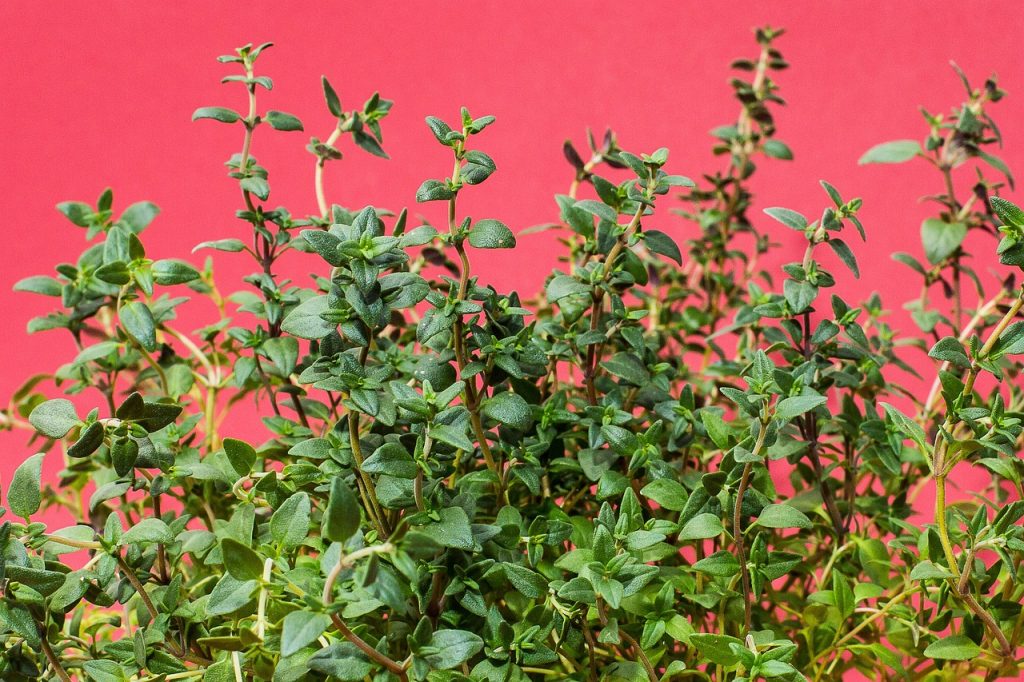
Thyme (Thymus vulgaris) is a highly versatile herb renowned for its culinary uses as well as its ornamental prowess in Mediterranean gardens. This hardy perennial is characterized by its small, evergreen leaves that release a warm, aromatic fragrance when crushed. The plant blooms in late spring and early summer, producing clusters of tiny, tubular flowers that can vary in color from white to pink and purple, providing both visual interest and a nectar source for pollinators like bees.
Thyme is remarkably adaptable to its native Mediterranean climate, thriving in poor, well-drained soils with full sun exposure. Its drought tolerance and ability to thrive in rocky, arid conditions make it an excellent choice for low-maintenance gardens. In addition to its resilience, thyme is a valuable herb in the kitchen. Its flavorful leaves complement a myriad of dishes, from roasted meats to hearty stews, and can even be used to infuse oils and vinegars.
In terms of landscape design, thyme is often used as a ground cover due to its low growth habit; it creates a dense mat that can crowd out weeds while emitting its delightful scent when stepped on. By planting thyme between stepping stones or in borders, gardeners can enhance the sensory experience of their outdoor spaces. Its minimal care requirements and dual purpose as a culinary herb make thyme an indispensable addition to any Mediterranean garden.
Mediterranean Spurge (Euphorbia characias wulfenii)
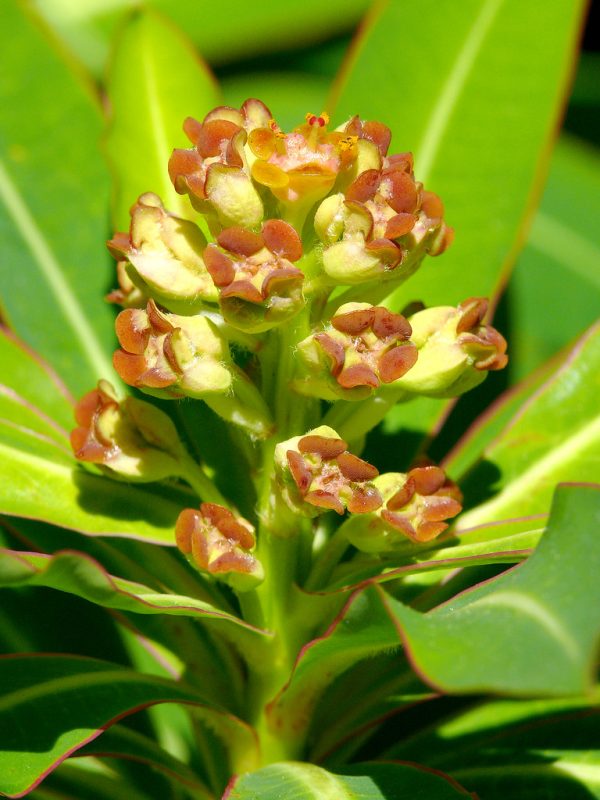
Mediterranean spurge (Euphorbia characias wulfenii) stands out in the Mediterranean garden with its striking appearance and unique architectural form. This evergreen perennial features thick, leathery leaves that form rosettes around the base, while its tall, stout stems showcase large clusters of bright yellow-green flowers that bloom in early to late spring. The vivid coloration and unusual flower structure contribute a dramatic flair that enhances garden aesthetics.
A notable characteristic of Mediterranean spurge is its adaptability to dry conditions. It thrives in poor, well-drained soils typical of Mediterranean climates and is highly tolerant of drought once established. Its resilience extends to its ability to withstand various soil types, making it a popular choice for gardeners seeking sustainable landscaping solutions. Additionally, this species is resistant to many pests and diseases, allowing it to grow with minimal intervention.
In terms of ecological benefits, Mediterranean spurge provides habitat for a variety of pollinators and beneficial insects. Its flowers are particularly attractive to bees, making it a valuable addition for enhancing biodiversity within the garden. When designing a Mediterranean landscape, consider grouping Mediterranean spurge with other drought-tolerant plants for a striking visual display. The combination of its unique structure and vibrant flowers adds depth and character to the overall garden environment.
Echium pininana (Bugloss)

Echium pininana, commonly known as bugloss or Nanmore, is a dramatic and eye-catching plant native to the Canary Islands but perfectly suited for Mediterranean gardens. This biennial or short-lived perennial can reach heights of up to six feet, making it a standout feature in any landscape. The plant is characterized by its dense, tall spikes of beautiful blue flowers that bloom in the spring and can attract a wide range of pollinators, including bees and butterflies.
The striking visual appeal of Echium pininana comes from its thick, rosette-shaped leaves that form a generous base from which the flowering stalk emerges. Each flower spike blossoms with tubular flowers that start as pink buds before transforming into a vibrant blue hue. This dramatic flowering pattern not only brings a burst of color to the garden but also creates a visually stunning spectacle, especially when planted in groups.
Echium pininana thrives in full sun and requires well-drained, sandy soils, making it ideally suited to Mediterranean climates that experience low rainfall. Its ability to withstand dry spells and tolerate drought makes it a sustainable planting choice for water-wise gardens. Additionally, the plant is known to self-seed, allowing it to establish new generations throughout the growing seasons, contributing to its hardiness and resilience.
When incorporating bugloss into a Mediterranean garden design, consider placing it in areas where its height can provide vertical interest and act as a focal point. Pairing it with other drought-tolerant plants enhances the overall garden aesthetic while promoting a thriving habitat for pollinators. Its vibrant colors and striking growth habit make Echium pininana a beloved choice for gardeners seeking to create stunning Mediterranean landscapes.
Echinops ‘Veitch’s Blue’ (Globe Thistle)
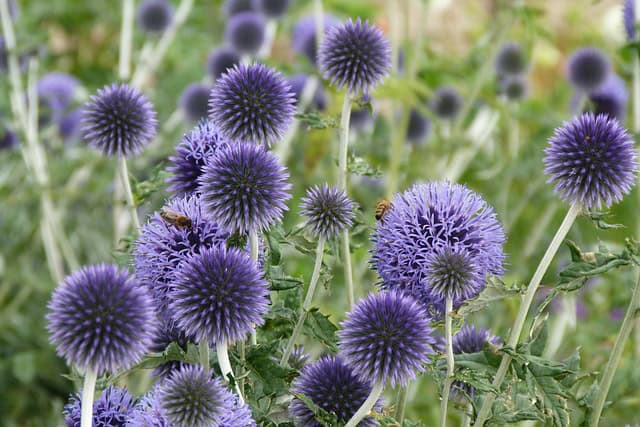
Echinops ‘Veitch’s Blue,’ or globe thistle, is a striking perennial often celebrated for its architectural structure and vibrant blue flowers that offer a unique appearance throughout the summer months. The plant is easily recognizable by its spiky, spherical flower heads, which can reach up to two inches in diameter. The bold, thistle-like blooms stand tall on sturdy stems, rising above the deeply lobed, gray-green foliage, creating a dramatic effect in the garden.
This globe thistle thrives in well-drained soils and full sun, making it an ideal candidate for the Mediterranean garden’s dry, sunny conditions. Echinops is not only drought-tolerant but also attracts a variety of pollinators, including bees and butterflies, which find their nectar irresistible. Its ability to self-seed means that once established, it can multiply, providing ongoing beauty to the landscape.
In terms of landscape use, Echinops ‘Veitch’s Blue’ can serve as a focal point in flower beds or mixed borders, contributing diverse textures and heights. The striking blue flowers can beautifully contrast with the warm hues of traditional Mediterranean plants, creating a stunning interplay of colors. Additionally, the dried flower heads can be harvested for use in floral arrangements, adding an extended period of enjoyment to the gardener’s efforts.
Achillea ‘Taygetea’ (Yarrow)
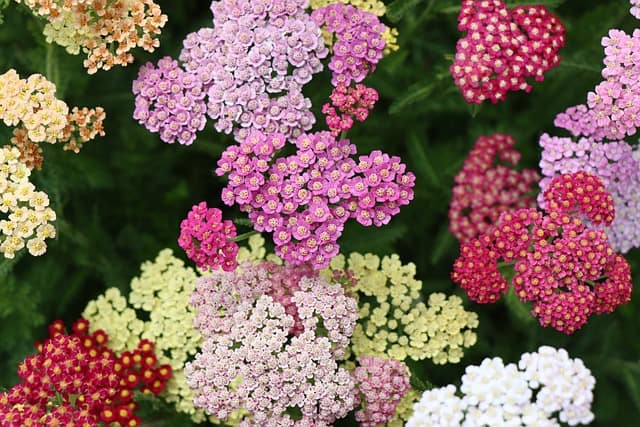
Achillea ‘Taygetea,’ commonly known as yarrow, is a stunning perennial that brings a splash of color and essential biodiversity to the Mediterranean garden. This particular variety is distinguished by its delicate fern-like foliage and clusters of bright yellow daisy-like flowers that bloom from late spring through summer. The flowers not only offer visual interest but also serve as a vital nectar source for butterflies and other pollinators.
Yarrow is well-known for its robustness, thriving in well-drained soils and requiring minimal water once established. Its natural resilience to drought makes it a perfect candidate for xeriscaping, reflecting the sustainability principles cherished in Mediterranean gardening. Beyond its ornamental value, Achillea has been historically favored for its medicinal properties, used in traditional herbal remedies for various ailments.
In landscape design, yarrow can be integrated into mixed borders, wildflower meadows, or cottage-inspired gardens due to its informal appearance. Its naturalistic growth habit allows it to blend beautifully with other perennials and grasses, creating a relaxed and inviting atmosphere. To keep the plants healthy, they benefit from occasional deadheading, which encourages further blooms and extends the flowering period. As a bonus, yarrow’s dried flower heads can be harvested for use in arrangements, adding to its versatility and charm.
Cotinus coggygria (Smoke Bush)
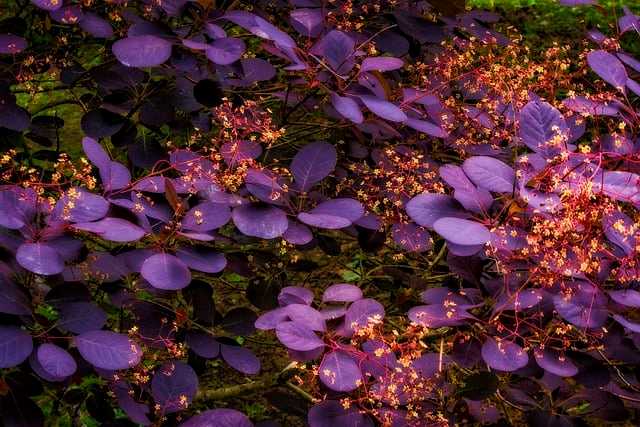
Cotinus coggygria, commonly referred to as smoke bush, is a striking deciduous shrub that captivates with its unique and dramatic features. This multi-stemmed shrub can grow up to 15 feet tall, showcasing rounded leaves that turn vibrant hues of yellow, orange, and red in the fall. However, it is the plant’s fluffy flower clusters that truly steal the show, creating a misty appearance reminiscent of puffs of smoke. This fascinating display occurs in late spring to early summer, offering a captivating conversation piece within the garden landscape.
Smoke bush is well-suited for the Mediterranean climate, thriving in well-drained soils and exhibiting drought resistance once established. Its adaptability to varying soil types and tolerance for poor conditions make it a desirable choice for gardeners seeking hardy yet visually appealing plants. Moreover, its resistance to pests and diseases means it requires minimal upkeep, fitting perfectly into a low-maintenance gardening philosophy.
In garden design, Cotinus coggygria provides vertical interest and can serve as a focal point in mixed borders or as a standalone specimen. Its colorful foliage and unique blooms harmonize beautifully with other Mediterranean plants, enhancing visual complexity. The ethereal nature of the ‘smoke’ in summer serves as an excellent backdrop for colorful annuals or perennials planted in front. Additionally, the dried flower plumes can be used in floral arrangements, allowing gardeners to appreciate their beauty long after the growing season has ended.
Phlomis tuberosa ‘Amazone’ (Jerusalem Sage)
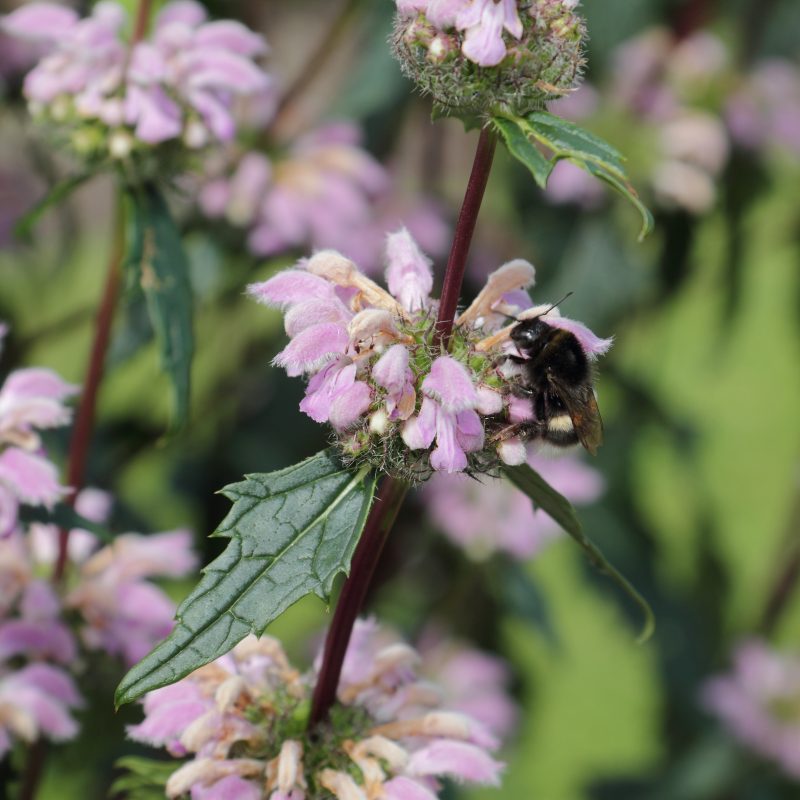
Phlomis tuberosa ‘Amazone,’ commonly known as Jerusalem sage, is an eye-catching perennial that makes a distinctive addition to Mediterranean gardens. Characterized by its striking whorled spikes of tubular yellow flowers, this robust plant blooms from late spring to early summer, providing a visual feast that attracts bees and butterflies. Its deep green, velvety leaves add textural interest and contribute to a lush garden atmosphere.
Jerusalem sage thrives in well-drained soils and prefers full sun, making it well-adapted to the hot, dry conditions typical of Mediterranean environments. Its drought tolerance once established allows gardeners to enjoy its beauty without the constant need for watering. Moreover, the foliage is aromatic; when brushed against, it releases a pleasant fragrance that enhances the sensory experience of the garden.
In terms of design, Phlomis tuberosa ‘Amazone’ pairs excellently with other drought-tolerant species, complementing their aesthetics and promoting biodiversity. Consider planting it in drifts for a bold statement or alongside grasses for a naturalistic look. Its unique blooms can provide valuable vertical interest amid lower-growing plants, creating a layered effect in the garden. The spent flowers can also be left on the plant, where they provide winter interest and seed heads for bird populations.



